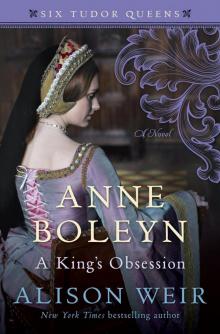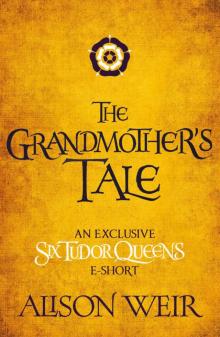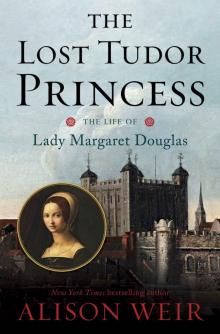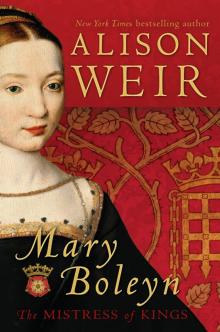- Home
- Alison Weir
Mary, Queen of Scots, and the Murder of Lord Darnley Page 26
Mary, Queen of Scots, and the Murder of Lord Darnley Read online
Page 26
Darnley was already at Stirling when Mary arrived, but she had preempted any refusal of his to become involved in the baptismal preparations by appointing Bothwell to take charge of them and to receive the ambassadors, which was “scarcely liked with the rest of the nobility.”18It was later alleged, in The Book of Articles, that Mary had a secret passage between her chamber and the great hall at Stirling constructed at this time, “thinking to have had access at all times by that mean to Bothwell, whom purposely she caused to be lodged at the north end of the great hall, as the unperfected work this day testifies, for they departed forth of Stirling before it could be perfect.” There are no building accounts to confirm this statement, and it is unlikely that a great noble such as Bothwell would have been lodged at the service end of the hall without some contemporary commenting on the fact; furthermore, it should be noted that the bridge giving access to the royal palace was at the south end of the 38.5-metre-long hall, and that the construction of a secret passage between one end and the other would have been a considerable undertaking that would have attracted much attention.
Melville says that, at this time, Mary was “still sad and pensive” and brooding on Rizzio’s murder, which was quite understandable, since she was being urged to pardon those who had committed it. “So many sighs would she give that it was pity to hear her, and few there were to endeavour to comfort her.” At length, after a supper at which she had sat sighing and refusing to eat, despite the pleas of Moray and Mar, she walked with Melville in the park at Stirling and unburdened herself of her grief. Melville comforted her by saying that her friends in England would soon help her to forget her enemies in Scotland, who were “unworthy of her wrath” anyway. He praised her “excellent qualities in clemency, temperance and fortitude,” and told her she “should not suffer her mind to be possessed with the remembrance of offences, but should rather bend her spirit by a princely and womanly behaviour, whereby she might best gain the hearts of the whole people, both here and in England.” He warned her to desist from the pursuit of further revenge, “whereupon may ensue more desperate enterprises,” and reminded her that she had repented of not heeding his warnings before the murder of Rizzio. “I pray God the like repentance fall not out again too late,” he concluded.19
Mary was also fearful of another conspiracy against her, and her Privy Council issued an edict forbidding anyone to bring firearms into the court.20 The Queen could not forget how Ker of Fawdonside had pressed his pistol against her belly on the night of Rizzio’s murder. Now, it seems, her fears were centred upon Darnley. Both Lennox and Buchanan refer to her dismissing the majority of his servants, but if this is true, she may have deemed it necessary to do so, in case they were plotting with him.
Lennox says that, in the absence of those servants, he appointed a number of his own dependants and followers to wait on Darnley at the baptism. Their arrival disconcerted and worried Mary, who expressed her disapproval and told Darnley that “there were too many Lennox men there, and if they were without the castle, they should not come in again. He answered they should go where he went, and if they were without the castle, and he with them, they should either enter with him, or he would make an entry for them.”21Melville also mentions this quarrel. Afterwards, Mary spoke sharply to Robert Cunningham, leader of the Lennox men,22presumably to warn him of what would happen to him and his followers if there was any trouble, but she did not go as far as to send them away, probably for fear of provoking further trouble.
According to The Book of Articles, Bothwell was so afraid of the Lennox men that he caused a dozen of his armed servants to watch in his bedchamber while he slept, and Mary, responding to his terror, summoned fifteen arquebusiers to the castle to act as Bothwell’s bodyguard; Mar, however, refused to let them in. However, this account presupposes that Bothwell was Mary’s lover at this time and that his fear arose from guilt.
Given Darnley’s defiance, it is hardly surprising that Mary should thereafter have tried to isolate him from the rest of the court. Both Lennox and Buchanan claim she did her best to prevent the nobles from having anything to do with him, but, according to Lennox, this only “inflamed their hearts the more against her,” so that the King’s “lamentable” case “won thereby the whole hearts of the nobility,” which is patently untrue, since several of them were plotting his removal. Lennox also alleges that Mary would have laid murderous hands on Darnley but for the imminent arrival of the foreign ambassadors, which obliged her to dissemble and defer the matter. On one occasion, though, she allegedly dropped her husband a hint of her intentions: during one of their quarrels, when Darnley grew red in the face at her “sharp words,” she told him that, “if he were a little daggered and had bled as much as my Lord Bothwell had lately done, it would make him look the fairer.”23
Buchanan says that Mary deprived Darnley of “any kind of expenses” and ordered him to be confined to “an obscure, narrow room,” but, although there is some evidence in de Silva’s dispatches that Darnley was short of money at this time,24it is clear that he came and went as he pleased, and it is unthinkable that Mary would have so shabbily treated the father of her child at a time when she was worried that he would not attend the baptism and would thereby disgrace her before the foreign ambassadors. Buchanan also claims that, much to Darnley’s distress, Mary had his silver plate taken away and replaced with pewter vessels, but elsewhere he contradicts himself, saying that the plate was removed after Darnley left Stirling.
More credibly, Buchanan states that the Queen forbade her husband to communicate with the ambassadors, “under pretext that his garments were not prepared.” Lennox says that he was not permitted to speak to them unless Mary was present, and claims that this was to prevent him from informing them of “her unnatural proceedings towards him,” but in fact it suggests that Mary was apprehensive that Darnley might either attempt to spread word of his grievances abroad, to her great embarrassment, or, worse still, would try to intrigue with foreign powers. Altogether, it appears that Mary was very afraid of Darnley and what he might do.
On 13 December, perhaps—it has been argued—with a view to enlisting the support of the Protestant establishment for the dissolution of her marriage to Darnley and the means by which she was to secure this, Mary approved further measures to aid the Kirk. A week later, she granted lavish gifts to the reformed Church.25
It was by a stroke of irony that Father Hay and the Bishop of Dunblane arrived in Edinburgh on 13 December. Learning that the Queen was at Stirling, they proceeded there immediately, but she was too busy with preparations for the christening to see them. Nor is it likely that she would have wanted to, for she must have known that they would do their utmost to persuade her to agree to Mondovi’s proposals. There is, indeed, no reliable evidence that Mary did speak with either Hay or the Bishop during their stay in Scotland; they, in turn, were under orders to report back to the Nuncio within a few days. On 23 December, Father Hay wrote to Mondovi, promising that he would soon be with him.26
On 14 December, the ambassadors gathered for the christening. Moretta had still not arrived, and the Queen had decided that the ceremony should go ahead without him.
Darnley had threatened to leave Stirling two days before the baptism, but showed no sign of departing. However, he kept to his own apartments,27sulking because he had not been consulted over the choice of godparents. He was not present when, on 16 December, Mary received the Earl of Bedford in audience and was presented with Queen Elizabeth’s christening gift of a richly enamelled, gem-encrusted gold font weighing 28 pounds.28During this audience, Bedford, to Mary’s great joy, informed her that his mistress wished to arrange a conference to discuss Mary’s claim to the English succession. At last, it seemed that her title was to be acknowledged, and she agreed to send some of her Councillors to “treat, confer and accord” with her royal cousin. Elizabeth’s friendship was also apparent in a letter she wrote to Darnley at this time, exhorting him to obey the Queen of Scots in all things.
<
br /> The Prince was christened, with full Catholic rites and appropriate splendour, on 17 December in the chapel royal at Stirling, and given the names Charles James, the former in honour of the King of France.29The Catholic ceremony, conducted by Archbishop Hamilton, drew adverse comment from alarmed Protestants, and several Lords, including Bedford, Moray, Argyll, Huntly and Bothwell, waited at the door of the chapel until it was over. Mary had provided new suits of clothing for her chief nobles: Moray’s was green, Argyll’s red and Bothwell’s blue.30The King of France’s ambassador carried the baby, attended by Atholl, Seton and other Scottish Catholic nobles, as well as by du Croc, who was standing in for the ambassador of Savoy.31The only part of the traditional rite that was omitted was that in which the priest customarily spat saliva into the infant’s mouth: Mary had expressly forbidden the syphilitic Archbishop Hamilton, whom she referred to as “a pocky priest,” to do this. At the end of the ceremony, the Countess of Argyll, acting as proxy for Bedford and Queen Elizabeth, took the baby, earning herself the severe censure of the Kirk.32
“The Queen behaved herself admirably well all the time of the baptism, and showed so much earnestness to entertain all the goodly company in the best manner that this made her forget in a good measure all her former ailments.”33For three days, Mary presided over the lavish festivities that had been devised to enhance Scotland’s prestige in the eyes of the world: there were banquets, masques, pageants, dancing, a bull hunt and a spectacular firework display. George Buchanan wrote a Latin masque, in which he extolled Mary’s virtues, while many of the other entertainments were devised or mounted by Mary’s favoured, able and witty valet, Sebastien Pagez, a native of Auvergne and an accomplished musician, singer and cook.34A ballet of his contriving gave great offence to some of the English visitors, for it depicted them as satyrs with tails, and Mary and Bedford had to employ all their diplomatic skills to defuse the situation.
Darnley was conspicuous by his absence. He kept to his apartments throughout the celebrations.35Buchanan claims he had been forbidden to attend, and Lennox that Mary asked him not to, but du Croc’s evidence makes it clear that this was Darnley’s own decision. On the day of the baptism, the King sent several times to du Croc, desiring me to come and see him, or to appoint him an hour that he might come to me in my lodgings; so that I found myself at last obliged to signify to him that, seeing he was in no good correspondence with the Queen, I had it in charge from the Most Christian King [Charles IX] to have no conference with him, and I caused tell him likewise that, as it would not be very proper for him to come to my lodgings, because there was such a crowd of company there, so he might know that there were two passages to it, and if he should enter by the one, I should be constrained to go out by the other. His bad deportment is incurable, nor can there ever be any good expected of him, for several reasons which I might tell you, were I present with you.
Du Croc may have been referring to Darnley’s possible homosexual activities, or he may even have suspected, without much concrete evidence to go on, that the King was again plotting against the Queen. Charles IX and Catherine de’ Medici may well have heard something of this in Paris, hence the orders to du Croc to have no dealings with Darnley. Certainly it seems as if Darnley was hoping to air his grievances and enlist at least du Croc’s sympathy, if not his support for his nefarious schemes; it is hardly likely, as Lennox implies, that he wanted du Croc to obtain Mary’s favour for him, for he had done his best to irrevocably alienate her by not attending the baptism.
Whatever du Croc had in mind when he wrote this letter, it was certainly too sensitive to be committed to paper. He concluded: “I cannot pretend to foretell how all may turn, but I will say that matters cannot subsist long as they are without being accompanied by sundry bad consequences.”36
Historians have long speculated about Darnley’s reasons for not attending the baptism. Du Croc believed that he stayed away because he did not want his obviously diminished status and others’ contempt for him to be apparent to the foreign ambassadors. According to Nau, Darnley feared that Bedford, as Queen Elizabeth’s representative, would refuse to acknowledge him as King of Scots, a fear that was probably well founded:37on the day of the baptism, the King had gone out by a back door “to take the air” and encountered a member of Bedford’s suite who “did him reverence”; this was reported to Bedford, who later reprimanded the man for disobeying Elizabeth’s order not to recognise Darnley as King of Scots.38More sinisterly, Darnley may have wished to cast doubts on the paternity of the Prince by his non-attendance, thereby emphasising his own right to the Crown Matrimonial. It has been pointed out that kings did not always attend their sons’ christenings—Henry VIII did not attend Edward VI’s—but the fact that Darnley’s absence drew adverse comment is proof that it was considered strange. Moreover, it was an unforgivable insult to his wife, whose honour he had publicly demeaned in the most humiliating manner.
Mary managed to retain her composure for as long as was necessary, but in private she was “pensive and melancholy,” and on 20 December, the day after the baptismal festivities came to an end, du Croc, responding to her summons, found her “weeping sore” on her bed, complaining of “a grievous pain in her side” and the enduring discomfort from her swollen breast. The ambassador came away with the worrying conviction that “she will give us some anxiety yet”—he could not think otherwise while she continued so depressed. “I am much grieved for the many troubles and vexations that she meets with,” he added.39There can be little doubt that Darnley was the chief cause of her distress, nor that it was exacerbated by the prospect of the exiles’ return. But worse was yet to come.
William Hiegait was the Town Clerk of Glasgow, a city at the heart of the Lennox landed interests. Some time in December, he thought fit to warn one William Walker, a servant of Archbishop Beaton who, by virtue of this connection, had access to the Queen, that he had heard that “the King, by the assistance of some of our nobility, should take the Prince and crown him; and, being crowned, as his father, should take upon him[self] the government.”40In order to accomplish this, Darnley would have needed foreign aid, since he and Lennox did not have sufficient men or resources to effect such a coup, nor would any of the chief nobles of Scotland have supported them. Of course, such a grandiose scheme could have existed only in Darnley’s imagination, but he had definitely been in contact with the Catholic powers in Europe in order to destroy Mary’s reputation as an advocate of her faith, and his dealings with them may have gone further than that. There has been speculation that Hiegait had been involved in Darnley’s plotting, but had thought better of it and decided that it was in his interests to warn the Queen what was afoot, although he was later to warn Darnley of a plot against him; at the very least, he appears to have been two-faced and duplicitous. Darnley’s plans had perhaps reached the point where maintaining discretion was no longer possible, which is how Hiegait had heard such detailed rumours of what Darnley was intending.
Hiegait also told Walker that “the King could not content and bear with some of the noblemen that were attending in our court, but either he or they behoved to leave the same.”41This must refer to those Lords who were working for the return of the exiles, Darnley’s mortal enemies. The fact that Darnley did leave court soon afterwards gives credence to Hiegait’s words. Neither Lennox nor Buchanan, however, says anything about Darnley’s ambitions, but it is inconceivable that they did not know of them: Buchanan was a Lennox man, and Lennox must have been heavily involved in his son’s schemes. Their silence argues Lennox’s complicity.
Unaware as yet of the full extent of her husband’s treachery, but goaded by his appalling behaviour, Mary had, it seems, decided after all to seek an annulment. On 23 December, in defiance of the Kirk, she restored Archbishop Hamilton to his consistorial jurisdiction,42which had been abolished in 1560 and which gave him the power to adjudicate in matrimonial cases. The fact that she took this extraordinary—and unlawful—step indicates just how desperate
she was to be free of Darnley; it was almost certainly to pre-empt censure for this that she had bestowed bounteous gifts on the Church of Scotland just three days earlier. Furthermore, the Archbishop, being a Hamilton, would be only too delighted to dissolve the marriage between the Queen and the son of his family’s long-standing enemy, Lennox, and he would certainly be more sympathetic and accommodating than the far more scrupulous Pope over the matter of James’s legitimacy. Canon law, however, decreed that marriages of royal persons could be dissolved only by the Pontiff himself,43but if Mary was not aware of this, Archbishop Hamilton should have been. In all, this was a highly injudicious and unwise step on Mary’s part.
The timing of the Archbishop’s restoration also argues that Mary’s purpose was the dissolution of her marriage, because, on the very next day, in order to secure the promised support of the Lords, she pardoned and recalled Morton and seventy-six other exiles. This was conditional upon them agreeing not to venture within seven miles of the court for two years. Two men were excluded from this general pardon: George Douglas and Ker of Fawdonside,44whom Mary considered had committed the worst kind of treason in threatening the lives of herself and her unborn child. Moray, Maitland, Bothwell, Atholl, du Croc and Morton’s kinsman, Archibald Douglas, had all been active in procuring the pardon,45although, according to a letter written by Bedford to Cecil on 9 January 1567,46it was also granted at the request of the English government. Clearly, Mary was paving the way for an amicable settlement of the English succession, but, given the fact that she needed the support of her Lords at this time of crisis, and the pressure that had been applied on her both in England and Scotland, she had really had little choice but to allow the exiles to return.

 Richard III and the Princes in the Tower
Richard III and the Princes in the Tower Britain's Royal Families: The Complete Genealogy
Britain's Royal Families: The Complete Genealogy The Lady in the Tower: The Fall of Anne Boleyn
The Lady in the Tower: The Fall of Anne Boleyn Six Wives of Henry VIII
Six Wives of Henry VIII Elizabeth of York: A Tudor Queen and Her World
Elizabeth of York: A Tudor Queen and Her World Captive Queen
Captive Queen Innocent Traitor
Innocent Traitor The Marriage Game
The Marriage Game A Dangerous Inheritance
A Dangerous Inheritance Katherine of Aragón: The True Queen
Katherine of Aragón: The True Queen The Marriage Game: A Novel of Queen Elizabeth I
The Marriage Game: A Novel of Queen Elizabeth I Princes in the Tower
Princes in the Tower Anne Boleyn: A King's Obsession
Anne Boleyn: A King's Obsession Traitors of the Tower
Traitors of the Tower Mistress of the Monarchy: The Life of Katherine Swynford, Duchess of Lancaster
Mistress of the Monarchy: The Life of Katherine Swynford, Duchess of Lancaster Queens of the Conquest: England’s Medieval Queens
Queens of the Conquest: England’s Medieval Queens Eleanor of Aquitaine: A Life
Eleanor of Aquitaine: A Life Mary, Queen of Scots, and the Murder of Lord Darnley
Mary, Queen of Scots, and the Murder of Lord Darnley Henry VIII: The King and His Court
Henry VIII: The King and His Court Queen Isabella: Treachery, Adultery, and Murder in Medieval England
Queen Isabella: Treachery, Adultery, and Murder in Medieval England Katheryn Howard, the Scandalous Queen
Katheryn Howard, the Scandalous Queen Arthur- Prince of the Roses
Arthur- Prince of the Roses The Wars of the Roses
The Wars of the Roses Eleanor of Aquitaine: By the Wrath of God, Queen of England
Eleanor of Aquitaine: By the Wrath of God, Queen of England Mary Boleyn: The Great and Infamous Whore
Mary Boleyn: The Great and Infamous Whore Jane Seymour: The Haunted Queen
Jane Seymour: The Haunted Queen Anna of Kleve, the Princess in the Portrait
Anna of Kleve, the Princess in the Portrait Lancaster and York: The Wars of the Roses
Lancaster and York: The Wars of the Roses The Grandmother's Tale
The Grandmother's Tale The Princess of Scotland (Six Tudor Queens #5.5)
The Princess of Scotland (Six Tudor Queens #5.5) The Lady Elizabeth
The Lady Elizabeth Katherine Swynford: The Story of John of Gaunt and His Scandalous Duchess
Katherine Swynford: The Story of John of Gaunt and His Scandalous Duchess The Curse of the Hungerfords
The Curse of the Hungerfords The Lost Tudor Princess: The Life of Lady Margaret Douglas
The Lost Tudor Princess: The Life of Lady Margaret Douglas Eleanor of Aquitaine
Eleanor of Aquitaine Mistress of the Monarchy
Mistress of the Monarchy The Lost Tudor Princess
The Lost Tudor Princess Henry VIII
Henry VIII Anne Boleyn, a King's Obsession
Anne Boleyn, a King's Obsession A Dangerous Inheritance: A Novel of Tudor Rivals and the Secret of the Tower
A Dangerous Inheritance: A Novel of Tudor Rivals and the Secret of the Tower Elizabeth of York
Elizabeth of York Katherine of Aragon, the True Queen
Katherine of Aragon, the True Queen Katherine Swynford
Katherine Swynford Wars of the Roses
Wars of the Roses Queens of the Conquest
Queens of the Conquest Mary Boleyn
Mary Boleyn Britain's Royal Families
Britain's Royal Families The Tower Is Full of Ghosts Today
The Tower Is Full of Ghosts Today Life of Elizabeth I
Life of Elizabeth I Anne Boleyn A King's Obssession
Anne Boleyn A King's Obssession Lancaster and York
Lancaster and York Jane Seymour, the Haunted Queen
Jane Seymour, the Haunted Queen Queen Isabella
Queen Isabella The princes in the tower
The princes in the tower